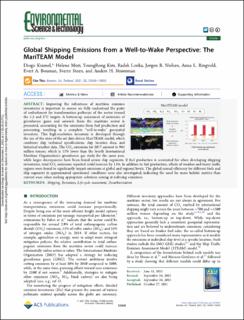| dc.contributor.author | Kramel, Diogo | |
| dc.contributor.author | Muri, Helene | |
| dc.contributor.author | Kim, YoungRong | |
| dc.contributor.author | Lonka, Radek | |
| dc.contributor.author | Nielsen, Jørgen Bremnes | |
| dc.contributor.author | Ringvold, Anna L. | |
| dc.contributor.author | Bouman, Evert Alwin | |
| dc.contributor.author | Steen, Sverre | |
| dc.contributor.author | Strømman, Anders Hammer | |
| dc.date.accessioned | 2021-12-03T09:35:31Z | |
| dc.date.available | 2021-12-03T09:35:31Z | |
| dc.date.created | 2021-10-28T21:08:16Z | |
| dc.date.issued | 2021 | |
| dc.identifier.citation | Environmental Science and Technology. 2021, 55 (22), 15040-15050. | en_US |
| dc.identifier.issn | 0013-936X | |
| dc.identifier.uri | https://hdl.handle.net/11250/2832705 | |
| dc.description.abstract | Improving the robustness of maritime emission inventories is important to ensure we fully understand the point of embarkment for transformation pathways of the sector toward the 1.5 and 2°C targets. A bottom-up assessment of emissions of greenhouse gases and aerosols from the maritime sector is presented, accounting for the emissions from fuel production and processing, resulting in a complete “well-to-wake” geospatial inventory. This high-resolution inventory is developed through the use of the state-of-the-art data-driven MariTEAM model, which combines ship technical specifications, ship location data, and historical weather data. The CO2 emissions for 2017 amount to 943 million tonnes, which is 11% lower than the fourth International Maritime Organization’s greenhouse gas study for the same year, while larger discrepancies have been found across ship segments. If fuel production is accounted for when developing shipping inventories, total CO2 emissions reported could increase by 11%. In addition to fuel production, effects of weather and heavy traffic regions were found to significantly impact emissions at global and regional levels. The global annual efficiency for different fuels and ship segments in approximated operational conditions were also investigated, indicating the need for more holistic metrics than current ones when seeking appropriate solutions aiming at reducing emissions. | en_US |
| dc.language.iso | eng | en_US |
| dc.publisher | American Chemical Society | en_US |
| dc.rights | Navngivelse 4.0 Internasjonal | * |
| dc.rights.uri | http://creativecommons.org/licenses/by/4.0/deed.no | * |
| dc.title | Global Shipping Emissions from a Well-to-Wake Perspective: The MariTEAM Model | en_US |
| dc.type | Peer reviewed | en_US |
| dc.type | Journal article | en_US |
| dc.description.version | publishedVersion | en_US |
| dc.source.pagenumber | 15040-15050 | en_US |
| dc.source.volume | 55 | en_US |
| dc.source.journal | Environmental Science and Technology | en_US |
| dc.source.issue | 22 | en_US |
| dc.identifier.doi | 10.1021/acs.est.1c03937 | |
| dc.identifier.cristin | 1949452 | |
| dc.relation.project | Norges forskningsråd: 294771 | en_US |
| dc.relation.project | Norges forskningsråd: 237917 | en_US |
| dc.relation.project | Notur/NorStore: NS9576K | en_US |
| dc.relation.project | Notur/NorStore: NN9576K | en_US |
| cristin.ispublished | true | |
| cristin.fulltext | original | |
| cristin.qualitycode | 2 | |

